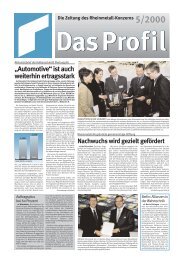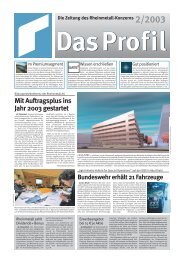Annual Report 2001 - KSPG AG
Annual Report 2001 - KSPG AG
Annual Report 2001 - KSPG AG
You also want an ePaper? Increase the reach of your titles
YUMPU automatically turns print PDFs into web optimized ePapers that Google loves.
82<br />
Consolidated financial statements <strong>2001</strong> of Kolbenschmidt Pierburg <strong>AG</strong><br />
Notes<br />
Accounting principles<br />
Deferred taxes<br />
Deferred taxes are duly recognized on<br />
the differences between the values of<br />
assets and liabilities in the consolidated<br />
balance sheet and those in the<br />
individual companies' tax accounts if<br />
such different values entail a higher<br />
or lower taxable income than would be<br />
the case if the consolidated balance<br />
sheet prevailed. Differences between<br />
the investment book value in the tax<br />
accounts and the investee’s equity<br />
are not recognized since, for lack of<br />
any intention to dispose of such investees,<br />
the valuation differences will<br />
not reverse in the foreseeable future.<br />
Deferred tax assets also include tax<br />
reduction claims from the expected<br />
future utilization of tax loss carryovers<br />
(if their realization is reasonably certain).<br />
If the recent history of a company<br />
reports a series of losses, deferred<br />
tax assets from unutilized tax<br />
losses or credits are only recognized<br />
to the extent that the company shows<br />
sufficient taxable temporary differences<br />
or that conclusive substantive<br />
evidence exists which suggests with<br />
reasonable assurance that sufficient<br />
taxable income will be earned by the<br />
company to utilize the hitherto unused<br />
tax losses or credits. Deferred taxes<br />
are determined by applying the local<br />
tax rates current or anticipated in each<br />
country at the time of realization.<br />
Due to the reduction in corporate income<br />
tax rates, resolved and meantime<br />
enacted in Germany under the<br />
tax reform, to a standard 25 percent,<br />
the prior-year deferred tax rate had to<br />
be clipped from 50 to 40 percent in<br />
Germany. Deferred tax assets and liabilities<br />
that reverse in future periods<br />
were adjusted accordingly, to the<br />
debit or credit of net income or equity,<br />
depending on whether initially recognized<br />
in net income or in reserves.<br />
Deferred taxation rates outside of<br />
Germany ranged between an unchanged<br />
32.5 and 38 percent.<br />
Minority interests Minority interests represent those equity as well as to Group net income.<br />
Accruals<br />
Accruals for pensions and similar obligations<br />
are determined according to<br />
the internationally accepted projected<br />
unit credit (PUC) method, which is<br />
predicated not only on expected future<br />
pay and pension increases but<br />
also other actuarial assumptions.<br />
The actuarial gains and losses ensuing<br />
from differences between actuarial<br />
assumptions and actual trends<br />
of the underlying parameters give rise<br />
to a gap between the present value of<br />
portions of a subsidiary’s net income<br />
and equity which are allocable to<br />
shares not held by Kolbenschmidt<br />
Pierburg <strong>AG</strong>, whether directly, or indirectly<br />
via other subsidiaries. Minority<br />
interests are shown in separate lines,<br />
in addition to debt and stockholders’<br />
the defined benefit obligation (DBO)<br />
and the pension liabilities accrued<br />
in the balance sheet. Actuarial gains<br />
and losses outside a 10-percent corridor<br />
of the DBO are distributed over<br />
the average residual service years of<br />
employees. The fair market value of<br />
any existing pension fund assets is<br />
deducted from pension accruals.<br />
Service cost is treated as personnel<br />
expense while the interest portion of<br />
pension provisions in the fiscal year<br />
is shown within the net financial<br />
result.<br />
Minority interests in losses are offset<br />
against the majority interests in the<br />
Group’s equity and Group net income<br />
unless a contractual obligation exists<br />
for the minority shareholders to absorb<br />
and offset such losses.<br />
The remaining accruals according to<br />
IAS 37 provide at balance sheet date<br />
for all identifiable legal and constructive<br />
commitments and obligations to<br />
third parties if based on past transactions<br />
or events and if their amount,<br />
due date or maturity is uncertain. If<br />
the probability of their utilization exceeds<br />
50 percent, accruals are measured<br />
at the best estimate of settlement<br />
amount. Noncurrent accruals are<br />
shown, if the effect of discounting is<br />
significant, at the settlement amount<br />
discounted as of balance sheet date.<br />
Liabilities Pursuant to IAS 39, liabilities are capital leases are recognized at the<br />
measured at amortized cost, which<br />
as a rule equals their settlement or<br />
repayment amounts. Liabilities under<br />
Prepaid and deferred items Such items are shown to appropriately Public grants and subsidies for<br />
recognize pro rata temporis (p.r.t.)<br />
prepaid rents, interest, insurance<br />
premiums, non-public investment<br />
grants or allowances, etc.<br />
present value of rents. Liabilities denominated<br />
in any non-euro currency<br />
are translated at the mean current rate.<br />
capital expenditures are recognized<br />
as deferred income in line with IAS 20.<br />
Operating income and expenses Net sales (revenues) and other oper- Operating expenses are recognized<br />
Derivative financial instruments<br />
Within the Kolbenschmidt Pierburg<br />
Group, financial derivatives are solely<br />
used to hedge against currency and<br />
interest rate risks from operations.<br />
In the prior-year accounts as of Dec.<br />
31, 2000, valuation units were regularly<br />
created between an underlying<br />
transaction and the offsetting hedge<br />
provided that, if intended and viewed<br />
at arm’s length, both the underlying<br />
transaction and the hedge were interrelated<br />
for one use and functional<br />
purpose, with the result that gains<br />
and losses from the underlying transactions<br />
and the hedge would very<br />
likely level. Where currency forwards<br />
contrasted with an asset or liability<br />
at balance sheet date, currency translation<br />
was based on the hedged rate.<br />
Where currency forwards referred to<br />
cash inflows or outflows in foreign<br />
currency, the derivative was not rec-<br />
ating income are recognized upon performance<br />
of the contract for goods/<br />
services or upon passage of risk to<br />
the customer.<br />
ognized due to the offsetting effect<br />
of the underlying transaction.<br />
An accrual provided for impending<br />
losses if a derivative was used to<br />
hedge proposed currency transactions<br />
and its market value was negative.<br />
Future interest rate differences from<br />
interest rate swaps were not recognized<br />
due to the compensatory effect<br />
of the underlying transaction. Option<br />
premiums paid when contracting interest<br />
rate or currency hedges, were<br />
carried under sundry assets at the<br />
lower of cost or market until the option<br />
was either exercised or expired.<br />
Upon the first-time application of IAS<br />
39 Financial Instruments as from<br />
January 1, <strong>2001</strong>, a financial derivative<br />
is initially recognized at settlement<br />
date, which would normally lag just a<br />
few days behind the trading date.<br />
Principally, any changes in the fair<br />
value of financial derivatives are<br />
immediately recognized in net income<br />
unless an effective hedge exists that<br />
when caused or when the underlying<br />
service, etc. is used.<br />
satisfies the criteria of IAS 39. In this<br />
case, the changes in the derivative’s<br />
value would not impact on net income<br />
until after the hedged underlying<br />
transaction has fallen due or<br />
been settled. If the derivative is a<br />
cash flow hedge (CFH) and hence<br />
used to effectively hedge expected<br />
future cash flows, changes in the<br />
financial derivative’s fair value are<br />
recognized under the other reserves<br />
only and not in net income.<br />
Changes in the value of financial derivatives<br />
used in fair value hedges<br />
(FVHs) to effectively hedge the fair<br />
value of recognized assets and liabilities<br />
are posted to net income as<br />
are any changes in the hedged assets<br />
or liabilities (where appropriate, by<br />
adjusting their book values), with the<br />
result that the compensatory effects<br />
are all reflected in the income statement.<br />
83


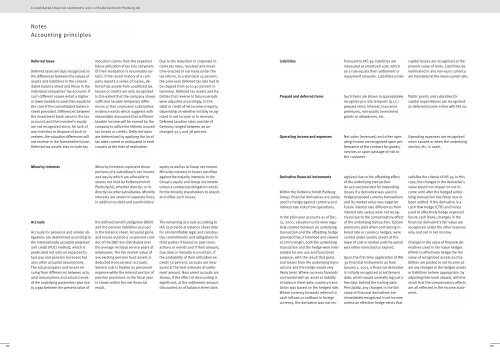
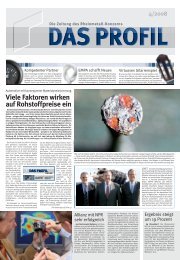

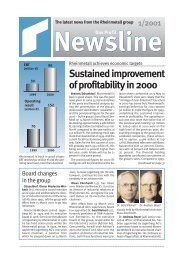
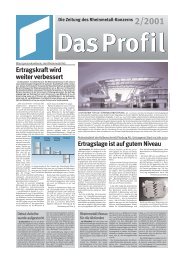
![PDF [1.0 MB] - KSPG AG](https://img.yumpu.com/5513074/1/171x260/pdf-10-mb-kspg-ag.jpg?quality=85)


